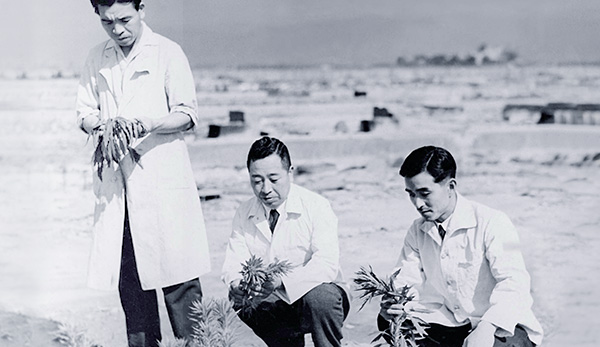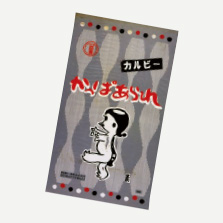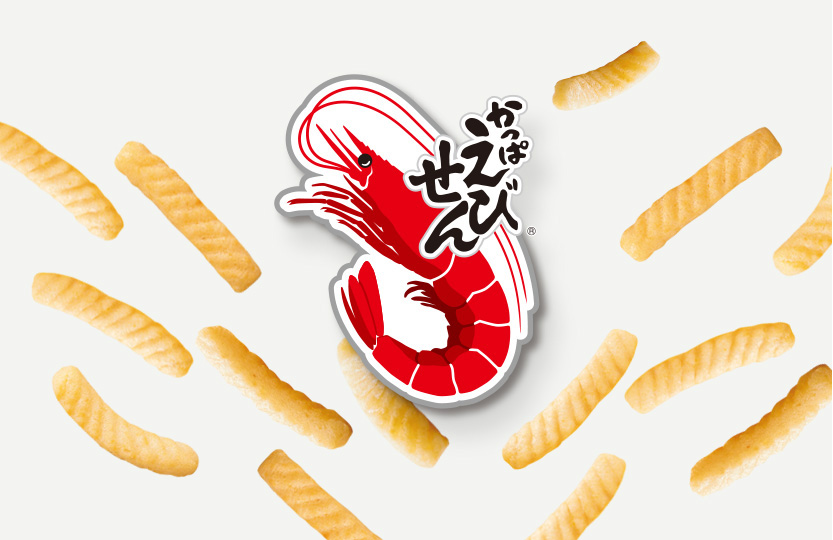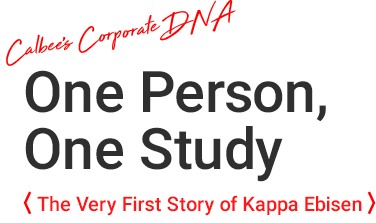Calbee's Corporate DNA

Founder of Calbee, Inc.
Takashi Matsuo
Born 1912 in Hiroshima City, Hiroshima Prefecture
01The Story of a Young Man and His Product: The Beginning of Calbee's History
The "utilization of untapped food resources" is the basic concept of Calbee, Inc., a company that has launched countless products over the years based on that concept. Some examples are: Sapporo Potato and Potato Chips developed by turning whole potatoes—those which used to be consumed mostly in the form of starch—into tasty snacks; and JagaRico developed by utilizing off-specification potatoes unfit for making Potato Chips. The concept, which can be called Calbee's corporate DNA when it comes to creating products, started with just one person and just one product: Takashi Matsuo, the founder of Calbee and Kappa Ebisen shrimp crackers. Kappa Ebisen, which was launched in 1964 and eventually achieved annual sales of 10 billion yen, and Takashi Matsuo, who invented the product, established a spirit that has underscored Calbee's dramatic evolution from a minor enterprise into a growing company and is still being practiced as its corporate DNA. Now, let us tell you the very first story of Kappa Ebisen.
02"One Person, One Study": The Phrase that Led to the Birth of "Calbee"
Takashi Matsuo, the founder of Calbee, was born to a family manufacturing and selling rice bran as animal feed and industrial material. The business was facing financial woes with an enormous amount of debt when Takashi took it over at the age of 18. With no financial resources or new trading opportunities, Takashi, still in his teens, looked hard for a new direction in business. Through his efforts, he was told something that would later lead him to the concept of "utilizing untapped food resources," which later became corporate DNA at Calbee. The thought-provoking words he heard came at a lecture of a local youth wing, which he joined at the age of about 20: "You, young ones, should serve as chains that link the past to the future. Dedicate your life to any work, whatever it may be, that will remain in future generations. That is, 'One Person, One Study'." Deeply impressed by this "One Person, One Study," Takashi set a vision to pursue his own "One Person, One Study"—production of healthy foods by using rice bran, which was then considered an industrial waste. He invented a machine to extract germ from rice bran, and he blended rice germ with wild grass and other ingredients to produce and sell dumplings as a food substitute. His dumplings were appreciated by many people suffering from the severe food shortage during the war, and that led to the idea of "creating food products for health," which is another corporate DNA of Calbee's today.
The origin of the company name (a portmanteau of "calcium" and "Vitamin B1") also reflects this idea.
 Former Hiroshima Factory
Former Hiroshima Factory
03Creation of Kappa Arare, Ancestor of Kappa Ebisen
 The "utilization of untapped food resources" took root in Calbee as unwavering policy. In 1945, when the war ended after the atomic bombing of Hiroshima, the company was forced to start over from scratch. Business picked up again in 1947, thanks to the production and sale of candies and caramels made from sweet potatoes and germ flour, but the prosperity did not last so long. Shifting tastes among consumers and various disasters put the company in danger of bankruptcy, but Takashi made strenuous efforts to turn the company around. And, in order to turn crisis into opportunity, he started developing new products other than candies. Instead of expensive and less accessible rice, which was rationed at that time, he focused on inexpensive wheat flour, which was imported in bulk from the United States. Confirming that wheat and rice have almost the same components, Takashi thought, "Wheat flour might make arare crackers, just like rice"; and, after repeated experiments, he finally created Kappa Arare in 1955 as Japan's first "wheat crackers." Partly because of the well-sounding word "kappa" (which refers to a mythical creature from Japanese folklore) in its name, Kappa Arare became a hit item and encouraged Takashi to develop other varieties of "kappa" wheat crackers. Kappa Ebisen appeared on the market as the final item in this series.
The "utilization of untapped food resources" took root in Calbee as unwavering policy. In 1945, when the war ended after the atomic bombing of Hiroshima, the company was forced to start over from scratch. Business picked up again in 1947, thanks to the production and sale of candies and caramels made from sweet potatoes and germ flour, but the prosperity did not last so long. Shifting tastes among consumers and various disasters put the company in danger of bankruptcy, but Takashi made strenuous efforts to turn the company around. And, in order to turn crisis into opportunity, he started developing new products other than candies. Instead of expensive and less accessible rice, which was rationed at that time, he focused on inexpensive wheat flour, which was imported in bulk from the United States. Confirming that wheat and rice have almost the same components, Takashi thought, "Wheat flour might make arare crackers, just like rice"; and, after repeated experiments, he finally created Kappa Arare in 1955 as Japan's first "wheat crackers." Partly because of the well-sounding word "kappa" (which refers to a mythical creature from Japanese folklore) in its name, Kappa Arare became a hit item and encouraged Takashi to develop other varieties of "kappa" wheat crackers. Kappa Ebisen appeared on the market as the final item in this series.
04DNA of Ceaseless Product Innovation
One day, Takashi was struck by inspiration when passing by shrimp that was being dried on the shore of the Seto Inland Sea. "Shrimp catching master" was Takashi's childhood nickname, as he was so good at catching shrimp, and shrimp was his favorite food. The biggest treat for him as a young boy was shrimp tempura, which his mother would make for him with whole fresh shrimp he caught in a neighborhood river. Those memories made him intuitively think, "Maybe I can make wheat crackers with my favorite shrimp." After painstaking trial and error, Kappa Ebisen shrimp crackers were finally launched in 1964. Takashi later recollects rejoicing upon completing Kappa Ebisen, thinking, "This is the one!" and believing with confidence that the product was precisely the fruit of his "One Person, One Study." It was, with no exaggeration, the moment that Calbee's policy of "using whole, good materials" that would later lead to the creation of products such as Potato Chips and JagaRico, was established. Kappa Ebisen is the cornerstone product at Calbee in terms of its manufacturing technology as well. For example, for the sake of freshness, which is critical to flavor preservation, the latest freezing technology was introduced ahead of other companies in order to freeze shrimp immediately upon landing to maintain their freshness during storage. From a marketing aspect, as well, the product successfully established a strong presence as a brand through a massive advertising campaign that included a TV commercial with the phrase, "Yamerarenai-Tomaranai." Now a long-selling product, Kappa Ebisen will continue to grow as a significant brand of Calbee's, together with the corporate DNA inherited from Takashi Matsuo, who kept inventing, challenging, and bringing innovations throughout his life.


